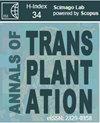肝、胰、十二指肠和肾联合移植治疗乙型肝炎肝硬化、尿毒症和胰岛素依赖型糖尿病
IF 1.1
4区 医学
Q3 SURGERY
引用次数: 2
摘要
背景腹部器官簇移植治疗上腹部终末期疾病是外科医生面临的一个严重难题。病例报告我们对一名患有终末期肝病、慢性乙型肝炎后肝硬化、尿毒症和胰岛素依赖型糖尿病的患者进行了四重器官移植(肝、胰腺、十二指肠和肾)的临床评估,并探讨了最佳手术程序。对一名46岁的男性同时进行了经典的原位肝、胰-十二指肠和异位肾移植。这一过程是对单血管吻合(肠系膜上动脉和腹腔动脉的Y移植物在髂总动脉中共同开放)手术的改进。胰腺分泌物和胆汁通过改良的未切割空肠环吻合排出,供体的肾脏放置在右髂窝。给患者开了巴西利单抗、糖皮质激素、他克莫司和霉酚酸酯治疗免疫抑制。术后第3天肝功能恢复良好,第1个月胰腺功能恢复良好。移植肾出现肾积水,POD 15的肌酐升高。因此,进行了肾盂穿刺和引流。他的肌酸酐在POD 42降至正常水平。没有发生同种异体移植物排斥反应或其他并发症,如胰腺渗漏、血栓形成或局部感染。患者在POD 365后具有正常的肝、肾和胰腺功能,且胰岛素不依赖。结论经典原位肝、胰十二指肠和异位肾移植是治疗胰岛素依赖型糖尿病合并终末期肝肾疾病的一种很有前途的选择,我中心的经验可为临床多器官移植提供参考。本文章由计算机程序翻译,如有差异,请以英文原文为准。
Combined Liver, Pancreas-Duodenum, and Kidney Transplantation for Patients with Hepatitis B Cirrhosis, Uremia, and Insulin-Dependent Diabetes
Background Abdominal organ cluster transplantation for the treatment of upper abdominal end-stage diseases is a serious conundrum for surgeons. Case Report We performed clinical assessment of quadruple organ transplantation (liver, pancreas, duodenum, and kidney) for a patient with end-stage liver disease, post-chronic hepatitis B cirrhosis, uremia, and insulin-dependent diabetes mellitus, and explored the optimal surgical procedure. Simultaneous classic orthotopic liver, pancreas-duodenum, and heterotopic renal transplantation was performed on a 46-year-old man. The process was an improvement of surgery implemented with a single vascular anastomosis (Y graft of the superior mesenteric artery and the celiac artery open together in the common iliac artery). The pancreatic secretions and bile were drained through a modified uncut jejunal loop anastomosis, and the donor’s kidneys were placed in the right iliac fossa. The patient was prescribed basiliximab, glucocorticoid, tacrolimus, and mycophenolate mofetil for immunosuppression. The hepatic function recovered satisfactorily on postoperative day (POD) 3, and pancreatic function recovered satisfactorily in postoperative month (POM) 1. Hydronephrosis occurred in the transplanted kidney, with elevated creatinine on POD 15. Consequently, renal pelvic puncture and drainage were performed. His creatinine dropped to a normal level on POD 42. No allograft rejections or other complications, like pancreatic leakage, thrombosis, or localized infections, occurred. The patient had normal liver, renal, and pancreas functions with insulin-independent after POD 365. Conclusions Simultaneous classic orthotopic liver, pancreas-duodenum, and heterotopic renal transplantation is a promising therapeutic option for patients with insulin-dependent diabetes combined with end-stage hepatic and renal disease, and our center’s experience can provide a reference for clinical multiorgan transplantation.
求助全文
通过发布文献求助,成功后即可免费获取论文全文。
去求助
来源期刊
CiteScore
2.50
自引率
0.00%
发文量
79
审稿时长
>12 weeks
期刊介绍:
Annals of Transplantation is one of the fast-developing journals open to all scientists and fields of transplant medicine and related research. The journal is published quarterly and provides extensive coverage of the most important advances in transplantation.
Using an electronic on-line submission and peer review tracking system, Annals of Transplantation is committed to rapid review and publication. The average time to first decision is around 3-4 weeks. Time to publication of accepted manuscripts continues to be shortened, with the Editorial team committed to a goal of 3 months from acceptance to publication.
Expert reseachers and clinicians from around the world contribute original Articles, Review Papers, Case Reports and Special Reports in every pertinent specialty, providing a lot of arguments for discussion of exciting developments and controversies in the field.

 求助内容:
求助内容: 应助结果提醒方式:
应助结果提醒方式:


